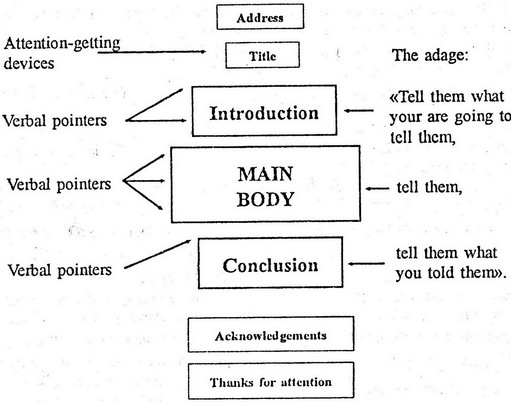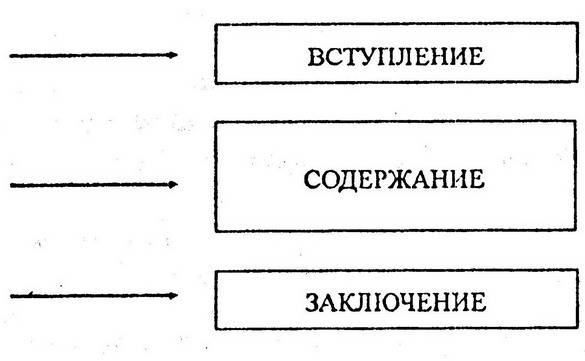
- •In science a guide for beginning research workers
- •199034, С.-Петербург, Университетская наб., 7/9.
- •199034, С.-Петербург, наб. Макарова, 6.
- •Preface Предисловие
- •Introduction Введение communication in science. Information exchange. Language skills Общение в науке. Обмен информацией. Виды речевой деятельности
- •Part I a scientific paper Научный доклад
- •1. Prior Work Предварительная (подготовительная работа)
- •Information Excange
- •2. Outline of a Paper / Communication / Report Cструктура доклада (сообщения)
- •3. Building an Effective Presentation Подготовка письменного текста с ориентацией на слушателей
- •4. Selecting and Using Visual Aids and Attention-Getting Devices Выбор и применение средств наглядности. Приемы привлечения внимания слушателей
- •5. What Makes Language Difficult to Understand? Что делает устный текст трудным для понимания?
- •6. Writing that Works. Paragraph Unity. Words and Phrases that Commonly Function as Transitional Devices Построение абзаца. Слова и словосочетания для передачи логической связи в тексте
- •7. Examples of Introductions, Conclusions and Acknowledgements Примеры вводной части доклада, заключений и выражения благодарности (признательности)2
- •Introduction
- •8. When You have Written your Paper Когда Вы уже написали текст доклада
- •9. A Model for a Paper Образец для написания научного доклада
- •Part II presenting a paper at a meeting Выступление с докладом на научной встрече
- •1. How to Present a Paper at a Meeting Как выступить с докладам перед аудиторией
- •2. If You are Speaking before the Audience Если Вы выступаете перед аудиторией
- •3. Elements of Delivery Элементы устного выступления
- •4. Conquering Speaking Anxieties Что6ы не бояться устного выступления
- •Remedies for Audience Inattention
- •Dealing with the Wandering Mind
- •Dealing with Speakers Amnesia
- •Dealing with Hecklers
- •Remedies for Hecklers
- •5.Speaker's Self-Evaluation Form Оценивание устного выступления
- •Part III information exchange at a scientific meeting. Listening comprehension Обмен информацией на научной встрече. Восприятие на слух
- •1. Listening Comprehension Восприятие на слух (аудирование)
- •2. Ask Questions when Necessary to listen effectively Для полноценного понимания задавайте вопросы
- •3.Are You a Good Listener? Хорошо ли Вы умеете слушать других?
- •4. Listener Evaluation Sheet Форма для оценивания навыка восприятия на слух
- •Part IV taking part in discussion Участие в обсуждении доклада
- •1. Improve your Communication Skill Развивайте свое умение общаться
- •2. Discussion. Asking and Answering Questions Обсуждение. Обмен вопросами и ответами
- •3. Discussion, Expressing an Opinion Обсуждение. Выражение мнения
- •Supplement Приложение
- •1. Академик а. А. Александров о нравственности в науке, этикете науки
- •2. An Opening Address (a Model) Образец вступительной речи председателя на научной встрече
- •3. Mathematical Formulae Математические формулы
- •Список авторов цитируемых высказываний
- •References Литература
Part I a scientific paper Научный доклад
1. Prior Work Предварительная (подготовительная работа)
Подготовка письменного текста доклада требует от аспиранта большой предварительной работы:
чтения целенаправленно отобранной научной литературы по теме исследования;
понимания особенностей научного стиля речи и его грамматической системы;
создания терминологического словаря изучаемого подъязыка;
накопления клише, характерных для научных статей изучаемого подъязыка;
знания особенностей структуры научного доклада;
умения строить текст доклада логично и последовательно, четко излагая содержание (см. схему «Outline of a Paper / Communication / Report»);
умения прогнозировать и учитывать восприятие доклада аудиторией и освоить приемы, способствующие установлению взаимодействия говорящего и слушающих (clear effective communication), т.е. полноценному научному общению (см. схему «Communication in Science» и соответствующие параграфы).
Communication in science
Language Skills
Information Excange

at
scientific meetings:
workshops
seminars
lectures
s
Understands
conversation and lectures
without effort
Understands almost
everything when spoken to slowly and clearl
c) Understands
with difficulty; needs repetition
and occasional translation
d) Cannot
follow conversation and lectures at all
Written
Reading
Writing
Speaking
Oral





Listening Comprehension





a terminology vocabulary
phraseology
units a
paper, a report an
abstract a
summary a
review paper
c
Speaks fluently, correctly
and is easily understood
Is easily understood, but
is not always fluent or correct
Speaks
broken English with many
mistakes annot
express simple ideas in
spoken English
lectures
papers
reports
discussions
scientific journals professional
journals abstract
journals conference
proceedings collections
of articles monographs
.v.







lectures
papers
reports
discussions
b) Writes
slowly with few mistakes
c) Writes
with difficulty and makes many mistakes
d) Cannot
express simple ideas
in writing
a) Reads
and understands without difficulty
Must read slowly, but
understands the context
Has problems understanding
the text and must use a dictionary often
Clear
communication results from partnership between
and



The
speaker must value the The listener must value the speaker
listener
and want to convey his and must want to understand the
or her
ideas clearly speaker s message
-
Grammar
Grammar
Grammar
Vocabulary
Vocabulary
Vocabulary
2. Outline of a Paper / Communication / Report Cструктура доклада (сообщения)

Есть старый, но не потерявший
своего значения СОВЕТ:

Расскажи слушателям, что ты
собираешься делать,
в то время, когда ты уже
делаешь, разъясни им, что ты
делаешь,
А когда сделано, расскажи им,
что ты сделал
The basic structure of a report is simple. It has three parts: an introduction, a body (a main body) and a conclusion, or, to put it in even simpler terms, a beginning, a middle and an end1.
So think of yourself as of a builder. And think of your report as a structure, as something that you actually build according to a definite architectural pattern. Keep in your mind the main divisions of the paper. The title is the key to the report or article.
When preparing an introduction you become an information seeker (searcher). You are to conduct a thorough review of the research literature, summarizing prior research. Give a description of current research interests: who else is working in the field? Who does what? What older works has this person written?
Conclusion summarizes briefly the main findings of the investigation.
«A whole is that which has beginning, middle and end».
Aristotle (384-322 b.c). Greek philosopher,
master of the theory of public speaking.
